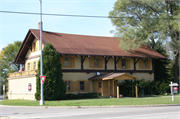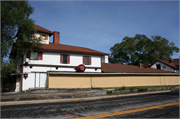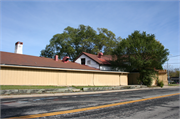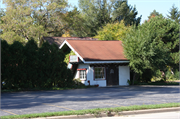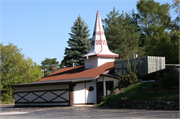Property Record
10401 N CEDARBURG RD
Architecture and History Inventory
| Historic Name: | August Gruenwald's Pioneer Inn |
|---|---|
| Other Name: | Alpine Village |
| Contributing: | |
| Reference Number: | 13814 |
| Location (Address): | 10401 N CEDARBURG RD |
|---|---|
| County: | Ozaukee |
| City: | Mequon |
| Township/Village: | |
| Unincorporated Community: | |
| Town: | |
| Range: | |
| Direction: | |
| Section: | |
| Quarter Section: | |
| Quarter/Quarter Section: |
| Year Built: | 1843 |
|---|---|
| Additions: | C. 1957 |
| Survey Date: | 19752017 |
| Historic Use: | lodging-inn |
| Architectural Style: | English Revival Styles |
| Structural System: | |
| Wall Material: | Stucco |
| Architect: | |
| Other Buildings On Site: | |
| Demolished?: | Yes |
| Demolished Date: | 2020 |
| National/State Register Listing Name: | Not listed |
|---|---|
| National Register Listing Date: | |
| State Register Listing Date: |
| Additional Information: | SWISS CHALET DECORATIONBRACKETED WIDE OVERHANGING EAVES1ST FLR ADDITIONS 2017: Constructed of fieldstone and sheathed with plaster and featuring hand-carved, faux, half-timber (or “Riegelhaus”) detailing, this two-and-one-half-story, Swiss chalet-style structure (#13814) is topped with a side-gabled roof with wide, overhanging eaves with carved wooden knee bracing on the gabled ends and exposed wooden rafter tails along its primary (east) elevation. A gabled and enclosed, one-story entrance sheathed with faux logs is located along the center of the east elevation; an additional gabled overhang extends beyond the entry. A pair of double-hung windows is located to the left (south) of the entrance, while the space to the right (north) is devoid of fenestration. Indeed, this space originally held a 17-foot by 7-foot mosaic mural that depicted a harvest festival scene or “kilbi” in the Swiss Alps. Four, evenly-spaced multiple-light sash windows line the second floor, which is detailed with additional carved wooden trim and bracing. The building’s southerly elevation includes a (now) one-story wing sheathed with vertical board, above which is a balcony that retains its original carved wooden railing. A series of four, multiple-light sash windows line the second floor, while two windows are located within the gabled peak. All windows feature a modest wooden surround, as well as shutters. Extending the from main block’s west elevation is a two-story wing that further connects to a one-story section that ultimately connects to another two-story block. This westernmost block is faced with plaster and includes wooden trim at its center (between the first and second levels) as well as a hipped-roof belltower along the roof’s ridge. Windows are largely double-hung sash examples, except for the square windows formerly located in the tower (they were removed in September). Wooden shutters on the second floor of this block feature detailing of musical instruments. Two, small, free-standing buildings are also located on the property, one of which could not be photographed due to its location and the fact that the property has long been for sale and permission was not given to access the grounds. The smaller of the two (#234415), is sheathed with plaster and includes carved/scalloped wooden bargeboards. An exterior staircase leads to a faux, upper-level balcony. The one that could not be photographed rises one-and-one-half stories directly behind the one-story structure and features the same ornamentation found on the smaller, visible one. That building was called the “Kunsthaus,” and was used by Louis Buchel for making his pottery and other artwork. Regarding alterations, the two free-standing structures on the property, as well as the two-story block to the west, have changed little since they were built in the 1950s. However, the main block, has been substantially altered since it was originally built of fieldstone in the 1840s--most specifically, as a result of the 1950s alterations that transformed the building into its Swiss chalet-style exterior. Indeed, up until 2010, when the building ceased operations as “Alpine Village” the property retained a significant degree of [historic material] on both its exterior and interior. Following its 2010 sale, the restaurant changed to Mexican fare, resulting in the overall (gold) paint job to the building (the plaster, as well as the carved woodwork and shutters), as well as the removal of the handcrafted mosaic mural off of the front of the building. The artistic interior, however, remained largely intact, except, again, for the paint colors. Finally, the interior was significantly “stripped” of its artistic features, including some 1950s-era built-in items, as well as all of its kitchen equipment in September 2017. The main, two-and-one-half-story block of this structure reportedly dates to 1843. By no later than 1870, the property was run as a tavern by William Jaeger and his wife Wilhelmine. William died in 1883 and the business was taken over by August and Minnie Gruenwald, who established the Gruenwald Hotel there in 1887. The property would later transfer to Paul and Ella Gruenwald; however, Paul worked as a contractor. As of the late-1910s, the proprietor of the hotel-tavern was Emil J. Birth, who purchased the property from the Gruenwalds in 1928. At some point after 1939, the property was known as the Pine Tree Inn and was run by Ervin Jaeger. In 1949, the property was purchased by the Buchel brothers-Werner, Gene, Louis and Walter; their father had been a chef in charge of the Lichtenstein Castle kitchen on the Swiss-Austrian border. All four sons (and including another brother Joe) were trained (to cook) by their father; they also learned the art of woodworking and ceramics. In 1937, Werner came to the United States and three of his brothers followed. After cooking in various hotels and clubs, the brothers purchased the subject property and began making improvements to the property and began the Alpine Village restaurant. First they built two small structures to accommodate a kiln so that they could create pottery (including vases and bowls used in the restaurant); they also built a woodcarving house. Both buildings were done to reflect Swiss Chalet-style architecture. Shortly thereafter, they made alterations to the main building—altering the original stone exterior with plaster and wood trim, again following the architecture of their homeland. As of 1957, the alterations were noted as nearly complete. The interior featured a ceramic fireplace and other ceramic and wood-carved items were added to the facility as time permitted. In the 1980s, the business was purchased by long-time Alpine Village cook, Steve Petrie and his wife Cindy who, together, continued the business—and maintained the Swiss chalet character of the property until September 2010. The property was then purchased by Hugo and Janet Saynes, operators of Jalapeno Loco, which is located on S. Howell Avenue near Gen. Mitchell International Airport in Milwaukee. Following some redecorating, the building reopened as a second location for Jalapeno Loco, which continued in business until December 2011. The building then stood vacant and for sale for nearly six years. In September 2017, an auction was held to sell its kitchen equipment; at the same time, much of the original interior features were stripped and sold. The building was sold, “as is,” in January 2018. |
|---|---|
| Bibliographic References: | Citations for information in Additional Comments below: U.S. Federal Census, Population, 1870, 1880, 1900, 1910, 1920, 1930; “Mequon Hotel Owner Dead,” The Milwaukee Journal, 6 September 1946; Paul & Ella Gruenwald to Emil & Bertha Birth, WD (7 May 1928), 77/267, #96747; Advertisement (Pine Tree Inn), Prop. Ervin Jaeger, The Cedarburg News, (16 February 1949), 2; “Three Brothers Created Own Alpine Village,” Milwaukee Sentinel, 15 October 1957, Part 2, page 4; “Swiss Air Envelopes Alpine Village,” Milwaukee Sentinel, 23 November 1957; ‘Alpine Village Just That,” Milwaukee Sentinel, 14 October 1958. Although begun by all four brothers, in 1961, Eugene and Walter would leave to open Club Riversite in Mequon. Brother Louis never worked in the restaurant business but, instead, continued making artwork, “Restaurateur Buchel owned Alpine Village,” (Obituary for Eugene Buchel), Milwaukee Journal Sentinel, 8 December 1995. |
| Wisconsin Architecture and History Inventory, State Historic Preservation Office, Wisconsin Historical Society, Madison, Wisconsin |

